The AMD Ryzen 9 7900, Ryzen 7 7700, and Ryzen 5 7600 Review: Zen 4 Efficiency at 65 Watts
by Gavin Bonshor on January 9, 2023 9:00 AM ESTCPU Benchmark Performance: Power And Office
Our previous sets of ‘office’ benchmarks have often been a mix of science and synthetics, so this time we wanted to keep our office section purely on real-world performance. We've also incorporated our power testing into this section too.
The biggest update to our Office-focused tests for 2023 and beyond include UL's Procyon software, which is the successor to PCMark. Procyon benchmarks office performance using Microsoft Office applications, as well as Adobe's Photoshop/Lightroom photo editing software, and Adobe Premier Pro's video editing capabilities. Due to issues with UL Procyon and the video editing test, we haven't been able to properly run these, but once we identify a fix with UL, we will re-test each chip.
We are using DDR5 memory on the 12th and 13th Gen Core parts, as well as the Ryzen 7000 series, at the following settings:
- DDR5-5600B CL46 - Intel 13th Gen
- DDR5-5200 CL44 - Ryzen 7000
- DDR5-4800 (B) CL40 - Intel 12th Gen
All other CPUs such as Ryzen 5000 and 3000 were tested at the relevant JEDEC settings as per the processor's individual memory support with DDR4.
Power
The nature of reporting processor power consumption has become, in part, a bit of a nightmare. Historically the peak power consumption of a processor, as purchased, is given by its Thermal Design Power (TDP, or PL1). For many markets, such as embedded processors, that value of TDP still signifies the peak power consumption. For the processors we test at AnandTech, either desktop, notebook, or enterprise, this is not always the case.
Modern high-performance processors implement a feature called Turbo. This allows, usually for a limited time, a processor to go beyond its rated frequency. Exactly how far the processor goes depends on a few factors, such as the Turbo Power Limit (PL2), whether the peak frequency is hard coded, the thermals, and the power delivery. Turbo can sometimes be very aggressive, allowing power values 2.5x above the rated TDP.
AMD and Intel have different definitions for TDP that are, broadly speaking, applied the same. The difference comes from turbo modes, turbo limits, turbo budgets, and how the processors manage that power balance. These topics are 10000-12000 word articles in their own right, and we’ve got a few articles worth reading on the topic.
- Why Intel Processors Draw More Power Than Expected: TDP and Turbo Explained
- Talking TDP, Turbo and Overclocking: An Interview with Intel Fellow Guy Therien
- Reaching for Turbo: Aligning Perception with AMD’s Frequency Metrics
- Intel’s TDP Shenanigans Hurts Everyone
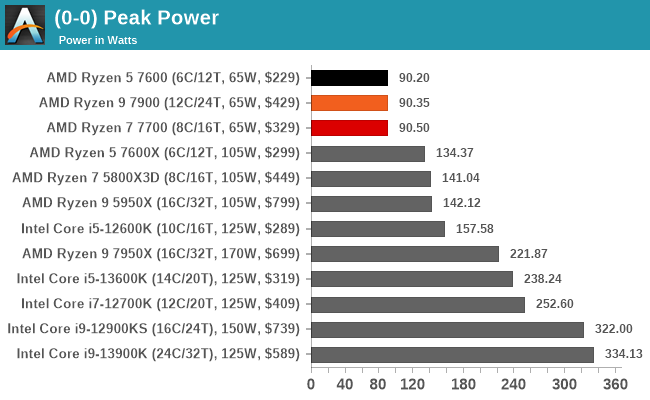
Regarding peak power, all three AMD's Ryzen 7000 65 W series for desktop topped out around 90 W under full load. This figure of 90 W was consistent throughout our power testing, which is within a couple Watts of AMD's Power Package Tracking (PPT) limits (~88W).
Looking at the power consumption of the Ryzen 9 7900 in more detail, we can see how it behaved under full load when running a workload using yCruncher. As we can see from the above graph, when the workload is called, and strain is placed on the Ryzen 9 7900, it immediately rose to 90 W and remained relatively consistent throughout the benchmark. and remained at the 90 W mark for around 193 seconds.
This was the same duration the benchmark took to complete, meaning that the Ryzne 9 7900 remained at its peak power for the full duration.
Office/Web

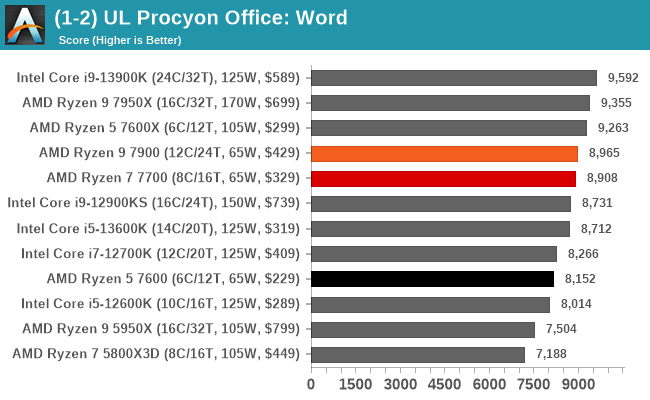
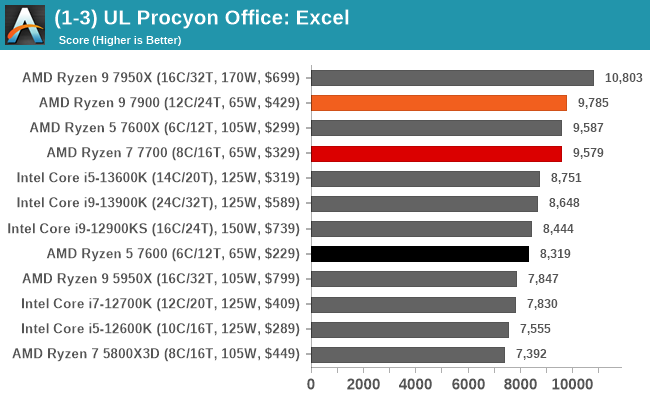
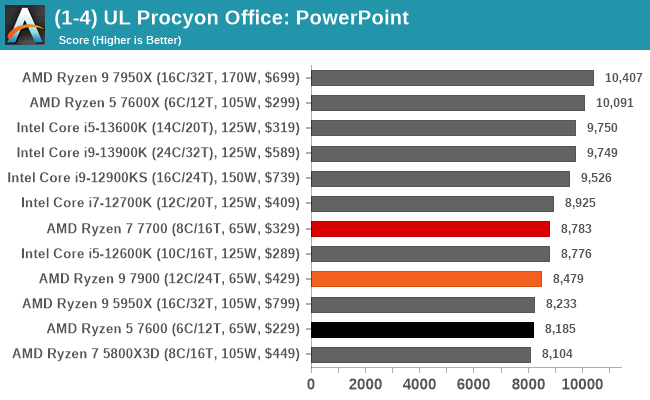
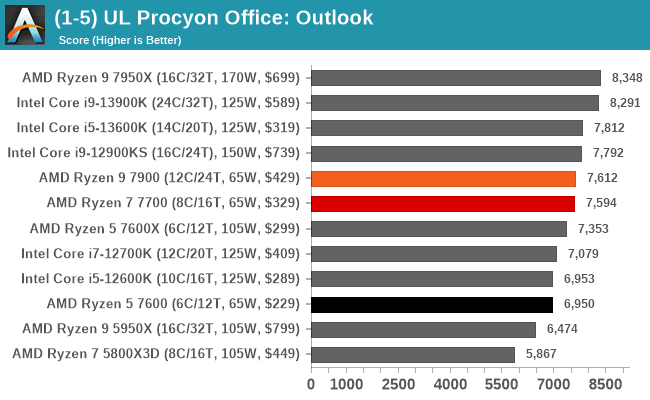
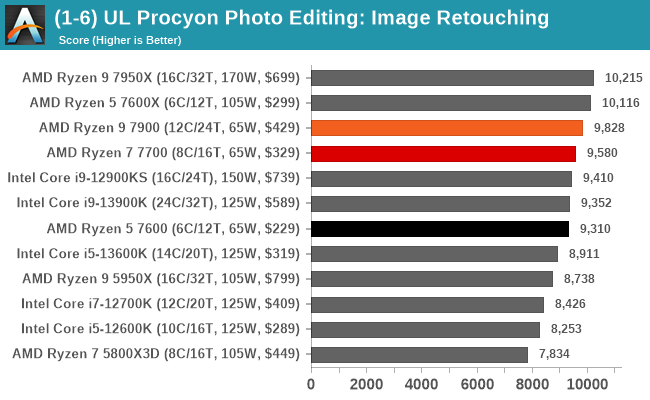
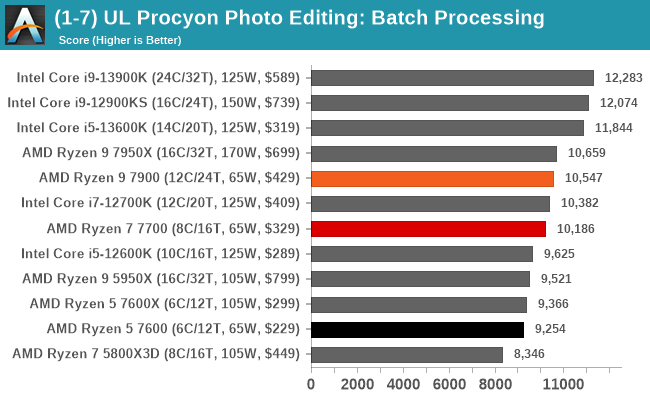
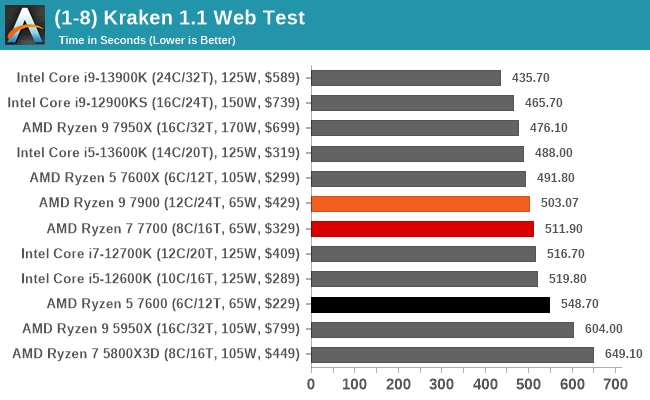
In our office and productivity benchmarks, the AMD Ryzen 9 7900, as expected, performed the best out of the three chips. All three chips in each of the office-based workloads comfortably beat out the Ryzen 9 5950X, which is impressive given the Ryzen 5 7600 is a 6C/12T part at 65 W TDP beating out a much beefier Ryzen 9 5950X that is a 16C/32T part, albeit on an older architecture.


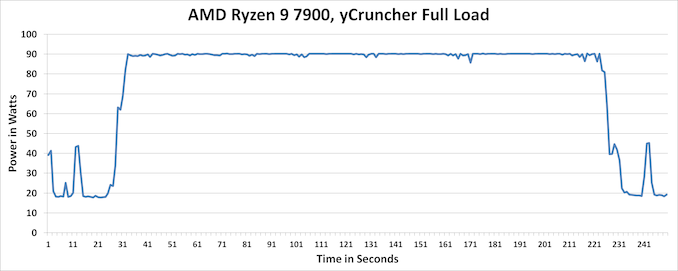








55 Comments
View All Comments
Maverick009 - Friday, January 13, 2023 - link
Linus Tech Tips actually did a review on these chips with benchmarks. The 7900 and 7900X are basically identical chips with one being 65W and the other being 170W, but the 7900 is also unlocked and if you use PBO, it can match its 7900X sibling with marginal performance differences on some programs and the upside being the 7900 is cheaper. I for one think I may pick the 7900 up for a build but I am also waiting on pricing for the 7900X3D and 7950X3D parts for my big gaming PC build that will replace my current 5900X.blzd - Friday, January 13, 2023 - link
I don't get how 7600 is beating 7600X in your F1 2022 and RDR2 gaming tests. By a large margin.It's identical other than lower clock speed and power limit yet performing faster somehow?
Kangal - Tuesday, January 31, 2023 - link
I noticed that too, and frankly, I cannot accept any of their gaming results here.blzd - Friday, January 13, 2023 - link
OC test results would be nice addition.Though not with the bundled heatsink of course haha. AMD included inadequate cooling for these CPU running at 99C under sustained workloads at factory clocks.
Thank you for the review!
Targon - Monday, January 23, 2023 - link
They can't run at 99C since AMD uses temperature as the basis for how high the clock speed will go. The default for the 7900X and 7950X was at 95 degrees C, and the chip won't go more than a degree above that point. With the temperature as the key, the chip will clock itself as high as cooling works, so better cooling results in higher clock speeds, and worse cooling will result in lower speeds, but you will never see temperatures above the max temperature.dicobalt - Wednesday, January 18, 2023 - link
Now if only it was possible to get a modern GPU will a low space heater factor that isn't based on an architecture that's positively ancient.Roy8oh - Friday, January 20, 2023 - link
Bundling coolers with its more affordable CPUs means users can spend their budget on a premium AIO cooler through better memory, storage, or graphics, which will have a positive impact on performance. What do u mean by that isnt aio cooler just cpu cooler liquid obviously but isnt it a cpu cooler or are you refering to fans ?AnitaPeterson - Sunday, January 22, 2023 - link
I am disappointed that the benchmarks do not include more samples from the Zen 3 family, aside from the 5800X3D. With many of us rocking Ryzen 3xxx and 5xxx, such a direct comparison would be much more useful than all the catalogue of horribly power-inefficient Intel chips that most people are not likely to buy anyway...mikato - Thursday, January 26, 2023 - link
"The Ryzen 7 7700 also performs well, but with just 8C/12T"Looks like that should be 16 threads, page 5.
dennphill - Monday, January 30, 2023 - link
OK, so I see a CPU that's a bit less power draw with a price close to last AMD generation. Would change my 5-5600X IF there was a descent motherboard that fits my mATX case! LOUSY selection so far of mATX motherboards from ASUS, Gigabyte, MSI, ASRock, etc. Upgrade needs AM5 motherboard and DDR5 (probably) in addition to 7000-series CPU. B650M expensive or crippled in capability and X670M boards are basically non-existent. Need to wait out until manufacturers decide offering to us need some degree of reasonableness in price and features. O(old)MHO. Thanks for good articles...I hope MB manufacturers read reviews AND comments.